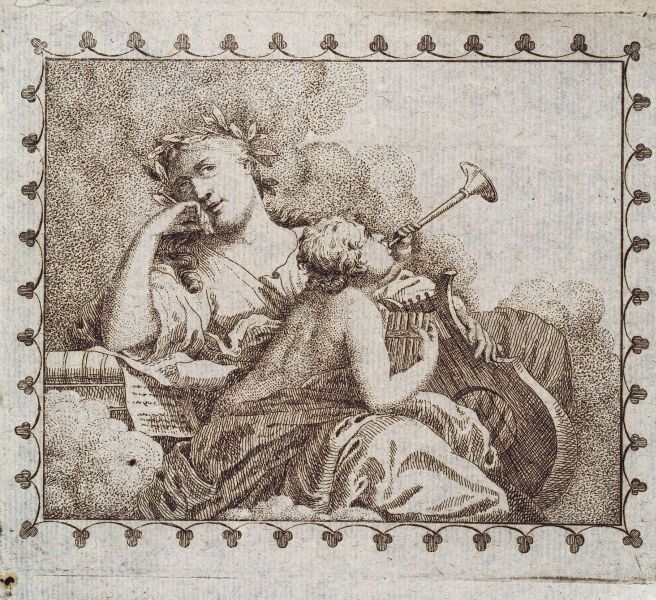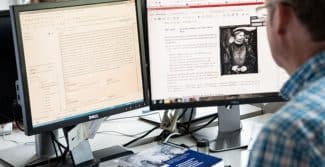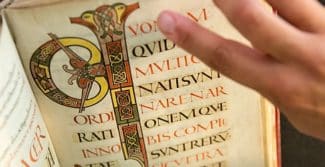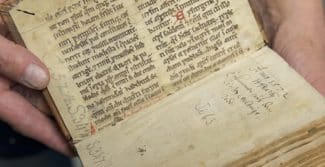30 November 2022
How did music sound in the year 1500? Shawm, pommer, slide trumpet – what did these instrument sound like and what do they have in common with the oboe, clarinet, trumpet or saxophone? The answers to such questions can only be inferred indirectly, and with some effort, because no recordings from that time exist of course. And how did musicians get their sheet music? It was possible to make copies, but it was a painstaking and costly process that was performed manually by scribes. The advantages that photocopying and scanning technologies have afforded cannot be overestimated. But in each case they still require access to an original manuscript or a copy or print thereof. This sheet music is found in archives and museums, and frequently also in libraries, which store and make it accessible to the public – one excellent example of this is the Herzog August Bibliothek (HAB) in Wolfenbüttel.
What kind of music can still be credibly played today on instruments from the 16th and 17th centuries, especially if the aim is to captivate a contemporary audience? Here, too, the HAB can help. Beside its collection of sheet music, which serves as a valuable starting point, it also has historical rooms whose acoustics bring out the best in the music of centuries gone by. For the promenade concert on 2 December 2022 four of these rooms were chosen as venues for four ensembles. To accompany each concert, HAB staff members presented a related object from the collection.
Pianist Markus Becker performed ‘Regarding Beethoven’ in the Augusteer Hall. On his home page, Becker describes the ideal moment of improvisation: ‘It is here that I express myself with all my defences down, so to speak – I make myself vulnerable. I let myself fall. If I feel this openness reciprocated by the audience, if the energy comes back to me, then a space can open up in which seminal, quasi-archetypal experiences are negotiated. The listeners can become active participants in a reciprocal event that, without the music, might never have come into being.’ Hole Rößler, deputy head of research planning and research projects, made the first presentation, of a baroque composition machine. This device allows even total amateurs to create four-part harmonies – and participate in the creative process of making music.
There was also a focus on improvisation in the garden room of the Lessinghaus. Here Lorenz Raab (flugelhorn) and Christof Dienz (electric zither) presented the programme ‘Sounds reworked: Jazz on the flugelhorn and electric zither’. Sarah Janke, a specialist in artist’s books, then picked up the theme in her presentation of an artist’s book that is itself an act of improvisation. Over the course of eight years, five international artists worked together to create a one-of-a-kind composition in book format comprising 196 pages: Lady Mikado’s Landscape by Uta Schneider, Ulrike Stoltz, Marshall Weber, Christopher Wilde and Kurt Allerslev.
The Ensemble Concerto Ispirato performed in the silver room at the Anna-Vorwerk-Haus. Under the artistic direction of baroque violinist Iris Maron, the musicians stated aim is to ‘breathe new life into old music through creativity and curiosity at the highest professional level’. It was in this spirit that the ensemble came together on 2 December for an evening dedicated to ‘Handel in Lower Saxony: Georg Friedrich Handel (1685–1759)’. In conjunction with this, Sven Limbeck, deputy head of the manuscripts department, presented the original handwritten score, which is held in the HAB (110 Mus.Hdschr.).
School students and Renaissance specialists came together in the Zeughaus to give a completely new rendition of works by the former court kapellmeister of Wolfenbüttel, Michael Praetorius (1571–1621), and some of his contemporaries. Working together with curators, historians and museum educators, the special ensemble Capella de la Torre developed the educational project ‘YOUNG PRAETORIUS’, in which musicians and members of the public were invited to experiment with playing historical instruments using original musical scores (or prints) in the HAB collection. They were, of course, working with exact copies to avoid damage to the originals. It was a multidisciplinary and multi-institutional project in the form of a concert. The aim was to build bridges, to familiarise young people with the music of the Renaissance and to challenge the idea of libraries and museums as merely places for exploring the past, recasting them as living places of direct experience as well. Young visitors were encouraged to infuse the projects with their own ideas and experiences. They were invited to get involved, ask questions and try out the instruments themselves. The process brought audience, organisers, musicians and participants into direct contact and created the conditions for new perspectives to emerge. ‘YOUNG PRAETORIUS’ looks back at the past, while also casting an eye forward into the future. As part of the occasion, HAB director, Peter Burschel, gave a presentation elucidating the wooden plaque, inscribed with the library’s regulations, that Herzog August had installed there 386 years ago.
A library can ‘sound’ quite wonderful, and historical instruments are only authentic if played live and with gusto for a contemporary audience. Dusty old instruments are literally a thing of the past! All the concerts were held twice: at 5 pm and 6 pm. This allowed visitors to ‘promenade’ between different eras, spaces and concerts. The event culminated in a reception in the Zeughaushalle.
PURL: http://diglib.hab.de/?link=125
Image (top): Unknown engraver, Music, 1676–1750. HAB: Graph. C: 417.
The author
Katharina Bäuml, born in Munich, studied modern oboe and graduated ‘with distinction’. She also studied baroque oboe and historical reed instruments at the Schola Cantorum in Basel, graduating ‘with distinction’. In 2005 she founded Capella de la Torre, Germany’s leading ensemble for Renaissance music today. Bäuml took on the role of artistic director for the promenade concert ‘Wir HABen Musik’ held on 2 December 2022.
Mehr...







